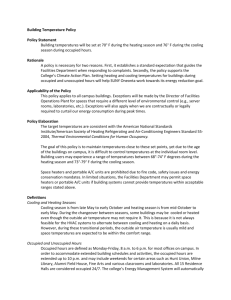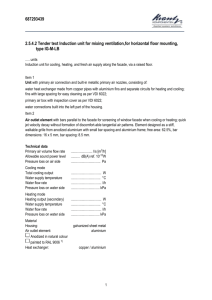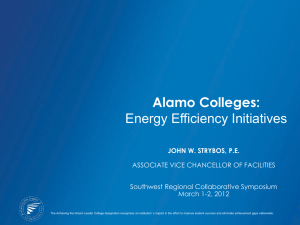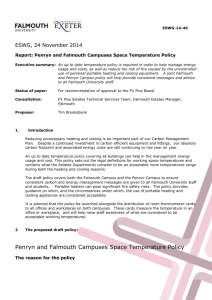Heating & Cooling Policy
advertisement
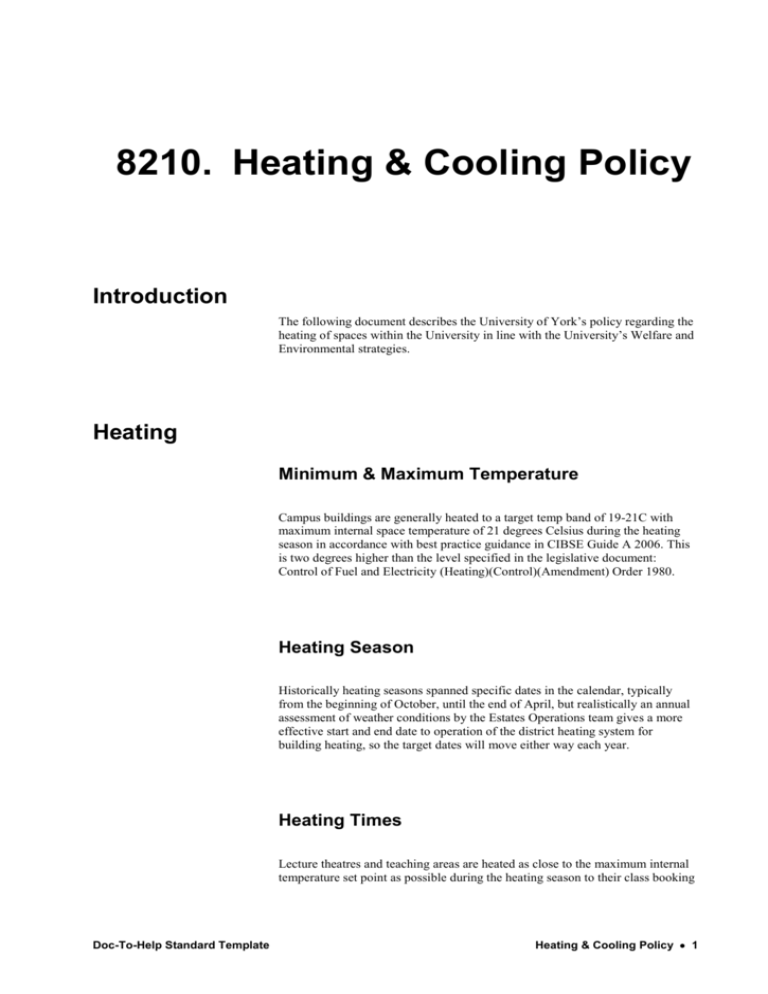
8210. Heating & Cooling Policy Introduction The following document describes the University of York’s policy regarding the heating of spaces within the University in line with the University’s Welfare and Environmental strategies. Heating Minimum & Maximum Temperature Campus buildings are generally heated to a target temp band of 19-21C with maximum internal space temperature of 21 degrees Celsius during the heating season in accordance with best practice guidance in CIBSE Guide A 2006. This is two degrees higher than the level specified in the legislative document: Control of Fuel and Electricity (Heating)(Control)(Amendment) Order 1980. Heating Season Historically heating seasons spanned specific dates in the calendar, typically from the beginning of October, until the end of April, but realistically an annual assessment of weather conditions by the Estates Operations team gives a more effective start and end date to operation of the district heating system for building heating, so the target dates will move either way each year. Heating Times Lecture theatres and teaching areas are heated as close to the maximum internal temperature set point as possible during the heating season to their class booking Doc-To-Help Standard Template Heating & Cooling Policy 1 times once these times are known. Similarly, library areas are heated during the heating seasons to cover their opening times. Accommodation is heated from 07.00 until 11.00 and 1400 - 23.00 every day to as close the maximum internal temperature set point as possible during the heating season Portable Heaters & Coolers The use of portable heaters is not recommended as: They constitute an increased fire risk to the buildings and occupants They can cause false temperatures to be sensed and prevent heating to be enabled. The electrical system is not designed for heavy load use such as multiple portable heaters; use of heaters can cause overload to occur and there is a potential disastrous failure of circuits. The University is committed to reduce its Carbon Footprint under the Carbon Management Implementation Plan. Electrical energy consumption produces approximately 3 times as much CO2 as other forms of energy Use of either portable electric heaters or air-conditioning cooling is not authorised in any University premises unless specifically agreed by Estates Services when existing systems have been found by Estates Services to be incapable of meeting acceptable conditions due to plant failure, building condition, or extreme climatic conditions. All electric heaters and air conditioning units used on University premises must be provided by the University Estates department. Cooling Cooling Provision There will be situations where personnel comfort cooling, will be required, however due to the additional electrical energy demand and maintenance implications they impose on the University, it is recommended that the requesting Department/School shall transfer an annual recharge into the University energy and A/C maintenance budget. All efforts should be made to ensure that comfort cooling is not required. To avoid the need for such systems the following principles should be adopted: General awareness training should be provided encouraging staff to use alternatives to refrigerant cooling to maintain an acceptable working environment by means such as use of opening windows and blinds for shading. Criteria for Refrigerant Cooling Provision Comfort Cooling shall only be considered where it can be shown that the internal work space of continuously occupied areas equals or exceeds 28C for 50% of the working day for 5 consecutive working days. OR The internal work space of continuously occupied areas equals or exceeds 28ºC for 50% of the working day for 3 consecutive days three times or more within a 12 month period. Unseasonable and unexpected weather conditions will not be a basis for the installation of cooling systems. Operating Criteria The following design/control measures shall be incorporated: a) System designed to maintain an internal temperature of a minimum of 22°C and shall be activated at 25°C. b) System controlled via the University’s Building Energy Management System and interlinked with the heating to avoid both systems being in conflict with one another. Accountability a) b) c) The funding of the capital, energy and maintenance costs for the cooling system shall be identified and agreed, prior to installation. The requirements of the system are checked annually for suitability. Energy accounting methods shall be provided in accordance with Building Regulations, Part L, latest editions. This Policy refers to comfort cooling only. When the function of an area requires specific operating conditions i.e. processes, specialist equipment, chemical storage etc. then such areas will be assessed independently. If it is concluded that cooling or air conditioning is necessary then para a) above shall apply. Doc-To-Help Standard Template Heating & Cooling Policy 3 Revisions Issue Date Revision By A 6/12/2010 First electronic manual issue PAB B 31/01/2011 Redrafted policy KW C 5/05/2011 Redraft simplified policy includes cooling KW D 07/06/2011 Minor amendments to heating / cooling criteria RH

